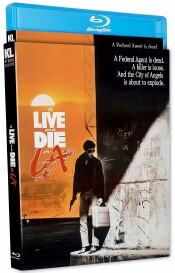Here is an interesting tidbit of information I uncovered while researching this film. When the film was initially released it was criticized for the lack of accomplished celebrities in its cast. This carries some serious irony given that the film features the likes of Willem Dafoe, William Petersen, John Pankow, Jane Leeves, and John Turturro, all of whom have gone on to become accomplished actors in their own right. All it took was time. Despite not being considered well known at the time, this was still a movie with great portrayals and snappy quips that made me laugh. In fact, the only thing to rival its story is the real-world implications it had afterwards, which we will get into in a bit. Petersen leads the film as Richard Chance, a Secret Service agent with a reputation for reckless, impulsive behavior, and, unbeknownst to his superiors in the Service, also corrupt. Petersen has his sights set on Dafoe’s Eric “Rick” Masters, a ruthless and skilled counterfeiter in Los Angeles. Though Petersen and Dafoe are the big draws for the film, the film is predominantly told from the perspective of Pankow’s Secret Service Agent John Vukovich, Chance’s partner who acts as the ying to Petersen’s yang. While Chance is corrupt, Vukovich is a by-the-book agent who chafes at the ideal of bending the rules. The dynamic reminds of me the relationship portrayed in Training Day between Denzel Washington and Ethan Hawkes’ characters. I’d go so far as to suggest that this film may have influenced or at least paved the way for that film.
“Make it real.” That was the instruction that director William Friedkin gave to the actors, and I have to say his will was done in everything from the car chase to the sex scenes. For example, Petersen did a lot of his own driving during the car chase sequence, and actor John Pankow’s stressed-out reactions were real. Authenticity was clearly the core intent for this film, and it worked. I was leaning in and wrapped up in the action. Additionally, the car chase sequence, in which the final escape by going the wrong way on the freeway, went on to gain quite a bit of prestige. According to my research, that sequence is consistently ranked among the best car chase sequences on film, often appearing alongside The French Connection (another Friedkin directed film), The Seven-Ups, The Blues Brothers, Ronin, and Bullitt.
I am a sucker for dialog, always have been. For me, dialog is what makes a movie. I am drawn to characters who are quick-witted and possess sharp tongues. Thankfully, this film has that in spades. Nearly every member of the cast has a snappy rejoinder locked and loaded. I wish I could share some of my favorites, but given that most of them are profanity-laced, you’ll just have to take my word for it about the quips. Or better yet, hear them for yourself, if you haven’t already.
Another interesting tidbit about the movie. The central crime of the film is counterfeiting, and despite the crew’s best efforts, some of the counterfeit bills made for the film got into circulation. In his memoir, director William Friedkin recounts that the fake money they made was so good that, after some of it left the set, he eventually heard from the Secret Service and a US Attorney. Not to mention the film depicts the step-by-step process that prompted people to attempt making their own counterfeit currency. That in itself is impressive and made me look at those scenes in new light.
What I enjoyed most about the film is the depiction of the internal struggle that Pankow contends with. His desires are at war with his ethics, and while he is willing to stand up to Peterson’s character at times and keeps trying to do the moral thing, he still finds himself backsliding into depravity and gets sucked into Chance’s “the ends justify the means” mentality. When their actions result in a death, this was a turning point for Pankow’s character, particularly given Peterson’s character’s flippant attitude regarding the situation. Following this, Pankow’s character is sent down a spiral that worsens with a reveal that ultimately alters his perception about the world. By the end of the movie, his character metamorphosis is unrecognizable. This felt authentic given the onslaught of betrayals and morally ambiguous circumstances that character undertakes. Who wouldn’t be forever changed? However, while this change is realistic, it actually promotes a bit of an evil-triumphing motif and the idea that you truly can’t trust anyone. For the time period, however, I believe it worked.



